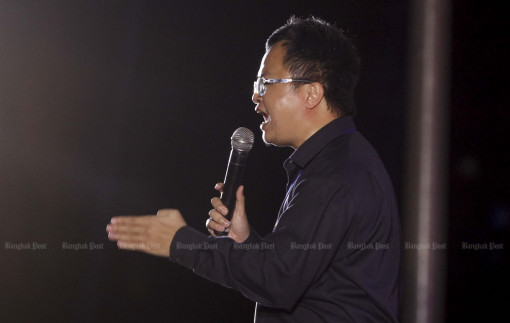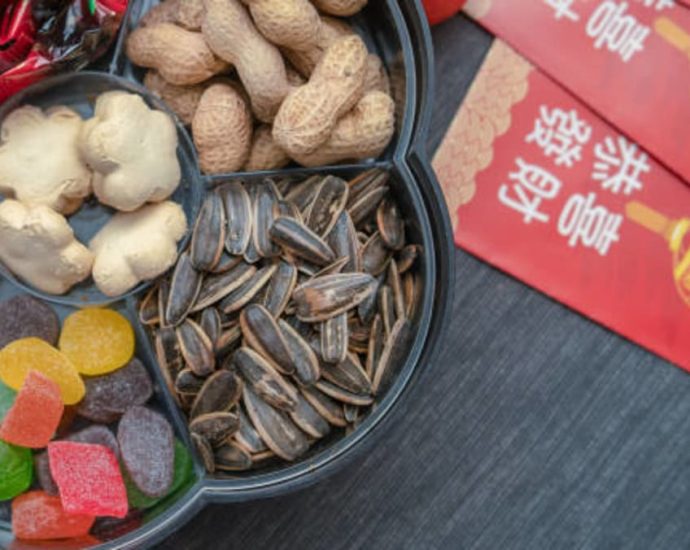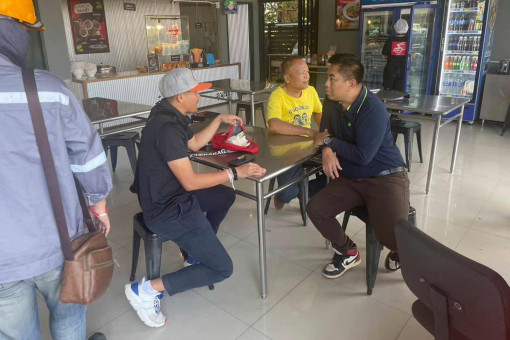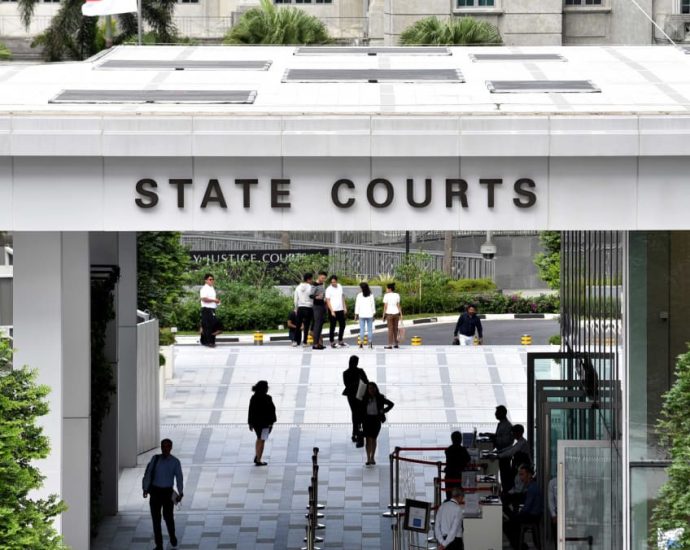Activist lawyer Arnon gets 4 more years
Court hands down second royal defamation conviction, 12 more cases still to be heard
PUBLISHED : 17 Jan 2024 at 14:49

The Criminal Court on Wednesday sentenced activist lawyer Arnon Nampa, 39, to four years in prison on Wednesday for royal defamation in connection with a social media post made in 2021, his lawyer said.
Mr Arnon, 39, is already serving a four-year sentence handed down last September for making remarks about the monarchy at a speech during a pro-democracy rally in 2020. The sentences will run consecutively, so he will serve eight years, local media reported.
The lese-majeste law, Section 112 of the Criminal Code, carries a maximum jail sentence of up to 15 years for each perceived royal insult, a punishment that international human rights groups have called extreme.
Wednesday’s ruling is the second of 14 cases against Mr Arnon, a lawyer-turned-protest leader of the youth-led movement that arose in 2020, calling for reform of the monarchy among other changes.
“Mr Arnon has denied wrongdoing,” his lawyer Krisadang Nutcharus told Reuters, adding that his team would lodge an appeal and if necessary, take the case to the Supreme Court.
Mr Arnon has been detained at the Bangkok Remand Prison since his sentencing on Sept 26 last year in the first lese-majeste chase.
After the courts rejected three petitions for his temporary release on bail pending appeal, he instructed his lawyers to abandon further attempts.
According to data from Thai Lawyers for Human Rights to Dec 31 last year, 1,938 people have been prosecuted for political participation and expression since the beginning of the Free Youth protests in July 2020. At least 262 are facing lese-majeste charges under Section 112 and 138 have been charged with sedition under Section 116. Nine cases under Section 116 came before the courts in December and all were dismissed.
Health Dept sounds alarm on falling birth rate
Ageing society will cause severe shortage of workers
PUBLISHED : 17 Jan 2024 at 14:38

PHETCHABUN: Thailand will face a labour shortage over the next 60 years with elderly people outnumbering those of working age if the declining birth rate remains unchecked, according to Heath Department director-general Atchara Nithiapinyasakul.
Speaking at a seminar in Phetchabun, Dr Atchara said more than 500,000 people died in 2023 while only 480,000 babies were born. It was the first time Thailand had recorded more deaths than births in a year.
This means that in the next six decades, 14 million working-age people will have to take care of 18 million senior citizens.
“Try to imagine it, that we board a plane but there are no pilots or flight attendants due to a labour shortage. And if hospitals lack doctors and nurses, who’s going to take care of the patients, most of whom are old?” she said.
“If the country lacks a working population, who will pay taxes? The Public Health Ministry must come up with a solution while also making this figure known to the public, so people can decide whether they want to have children or not.”
Dr Atchara cited the situation in Singapore and in Sweden.
“Singapore has to import labour from other countries because the government’s reproduction campaign was not attractive enough to persuade people to have more children.
“The Swedish government, meanwhile, uses incentives to encourage its people to get pregnant including paid maternal leave and child allowances. This effort has evidently increased the birth rate in Sweden over past decade.”
In Thailand, according to Dr Atchara, financial issues and a lack of government support were the main factors discouraging Thais from having children.
She suggested the ministry improve the welfare system and help couples who have fertility difficulties.
The Surrogacy Act should also be revised to allow same-sex couples to be parents through surrogacy, she said.
“This is not just a matter of fertility, but also of national security,” she said. The issues had been submitted to cabinet for discussion. Many state hospitals were were setting up fertility clinics, she said.
Hospitals in Phetchabun were pioneers in offering intrauterine insemination (IUI), the clinical injection of prepared sperm into a uterus.
As for invitro fertilisation (IVF), Maharat Hospital in Nakhon Ratchasima province and Hat Yai Hospital in Songkhla province were the only state-run hospitals offering this treatment, she said.
How to stop the Houthi-Iran Red Sea attacks
We now know more about how the Houthis and their Iranian partners use radar and satellite communications to target commercial vessels and US and UK warships. The US should thus be thinking about jamming Iranian radars that are being used to help the Houthis.
The US also needs to work with commercial satellite operators to shut down access to communications that guide Houthi missiles and drones. And the way the automatic identification system (AIS) is operated needs changed to confuse the Houthis and Iranians.
It is important to understand how the Houthis are going after merchant vessels and US and UK warships. To hit a ship with a drone or cruise missile, you need to know where the ship is at the time it is actually engaged.
The Houthis have a large arsenal of drones, cruise missiles and some ballistic missiles. Against moving targets, drones, or unmanned aerial vehicles (UAVs), have a high potential for accuracy.
There are nine types of Houthi drones: Hudhud-1, Raqib, Rased and Sammad-1 (reconnaissance UAVs – although the Sammad-1 can be weaponized), and Qasef-1, Qasef-2K, Sammad-2 and Sammad-3 (combat UAVs) and Wa-eed-2.
It appears that the drones being fired at commercial ships and US warships are either Qasef-1 or Qasef-2 or the Shahed-136, known as Wa-eed-2 by the Houthis. The Houthis may also have used their longer-range drones but these have been aimed at Israel, particularly the port city of Eilat.

The Shahed drone is the same kamikaze weapon Iran has supplied to Russia. Neither the Qasefs nor Shaheeds are first-person view (FPV), drones that send back live video to an operator or pilot who can then direct the drone to the moving target. FPV drones are being used heavily in Ukraine, even though they are subject to jamming.
As I reported in December, it is almost certain that the Houthis and Iranians are using the global AIS to track ships in the Red Sea and Persian Gulf, and more recently in the Indian Ocean. Virtually every commercial vessel over 300 tons operates an AIS transponder.
When ships are on the move, AIS broadcasts their location and speed as well as the name of the vessel every two to 10 seconds. Yet, while it can transmit information while on the move, AIS is not as accurate as radar.
According to a recent study, compared to radar the AIS transponder information was off by 97.72 meters (or around 320 feet). What this means is that using AIS to track ships may not ensure that a UAV or cruise missile hits its target.
What the AIS track can provide is the capability to interpret what the radar “sees.” In crowded shipping lanes, picking out a target isn’t easy. But with AIS the target can be identified, passed to a radar station and then followed by the radar.
By iterating AIS and radar, the Houthis or Iranians know where their target is in near real-time. (My own belief is that these complex operations are handled by Iranians.) The next trick is to communicate with the cruise missile or drone. How can this be done?
As targets move further away from the shoreline, direct radio communications become difficult, sometimes impossible. FPV drones can be operated over a distance of 8 to 10 kilometers from the operator but usually less.
The Houthis have already attacked a merchant ship (MV Gibraltar Eagle) on January 14, 177 kilometers from where the drone was launched. How could the drone or cruise missile strike a target that far from Houthi territory?
In early December 2023, a crashed Shahed-136 drone was recovered by the Ukrainians and yielded something surprising. The Iranian Shahed-136 suicide drone is now manufactured in Russia, where it is called Geran-2 (Geranium-2). It isn’t clear if the crashed drone was produced in Iran or Russia.

What marked this find as unique was the fact that the Shaheed drone was equipped with an Alcatel internet modem (model 1K41VE1) and a SIM card that belonged to a Ukrainian 4G cellular service called Kyivstar. There is a debate on how the Shahed worked with the Ukrainian cellular capability.

Shahed drones are usually preprogrammed and do not have cameras. But the recovered drone may have had a camera, which would give it the potential capability of hitting moving targets and not just fixed locations. That is, the cameras could transmit imagery back to operators on the internet, allowing remote operation and accurate attacks.
Something similar was found upon the recovery of Iranian drone parts that hit the Campio Square commercial ship on February 10, 2023. The tanker, which was hit in the Arabian Sea around 300 nautical miles off the coasts of India and Oman, flew a Liberian flag but was owned by an Israeli company called ELESON.
The part recovered was a SIM card for the global satellite communications company Iridium Communications, a Maclean, Virginia-based public company originally founded by Motorola. Iridium offers voice and data communications services to customers around the world.
SIM cards for Iridium satellites are widely available, including on Amazon and eBay. Modems to receive Iridium signals can be purchased directly from Iridium or third-party vendors. Iridium is especially popular for maritime use, where commercial cell phone connectivity is not available. Many military operations also use Iridium for connectivity.
Previously, the Russians allegedly used Iridium communications for Kartograf UAVs manufactured by AFM-Servers for the Russian Federal Security Service (FSB) and for use in the Ukraine war.
“The drone is designed for panoramic aerial photo and video recording with the ability to transmit the collected information to the control point in real time. It can be used for reconnaissance to correct artillery fire or missile strikes,” according to Bulgarian Military, an online news service not affiliated with the Bulgarian government.
If the Houthis incorporate Iridium SIM cards and modems in their Shahed-136 drones, and perhaps in other models, they would have a far better chance to accurately target commercial vessels.
So long as their coastal radars were operating, the Houthis could also target US military ships, provided they could find them. While US military ships have AIS systems, they don’t use them in combat areas and none of them are now operating with AIS in the Red Sea.
Without coastal radars functioning (reportedly the US and UK have knocked out three important Houthi coastal radars), the Houthis would need alternative ways to locate US warships.
They could be getting live feeds from either the Iranian spy ship equipped with radar operating near the Bab el-Mandeb Red Sea straits, the cargo ship Behshad, or the Iranian warship IRIS Alborz, an old British-made frigate that crossed through the Bab el-Mandeb strait on January 11, a day after the joint US-UK strike on the Houthis.
That ship also has radar and interestingly showed up almost on cue after the US-UK attack. These two ships could replace the radars the Houthis have lost. The Beshad replaced the MV Saviz, which was damaged by a limpet mine, allegedly by Israel.

For the US, it is important to localize Houthi attacks as much as possible and to degrade their targeting capability. One way to do this, aside from destroying their coastal radars, would be to jam the radars of the Iranian frigate and spy ship that may be feeding real-time targets to the Houthis.
Another way would be to interdict satellite communications supporting Houthi and Iranian operations, working with Iridium to accomplish the task. Iridium can locate accounts operating on these territories fairly easily. Shutting them down will take away an asset as important as the radars the US has targeted with Tomahawk missiles.
For merchant ships, where the way ahead is clear and open, turning AIS off and on at intervals would go a long way toward thwarting Houthi targeting.
This article was originally published on his Weapons and Security Substack. It is republished with kind permission.
S$167,000 lost to Facebook, Instagram scams involving Chinese New Year goodies
SINGAPORE: At least five victims have fallen prey to scams involving the sale of food items like Chinese New Year goodies since September 2023, losing about S$167,000 (US$124,000) in total. Many of the alleged fraudulent advertisements of food items were posted on Facebook and Instagram, police said in a news release on Wednesday (JanContinue Reading
Duo arrested with fake dollar bills worth B2.8m
Detectives who set up sting in Buri Ram were quoted a price of B200,000
PUBLISHED : 17 Jan 2024 at 14:05

BURI RAM: Police arrested two men with fake US dollar banknotes with a combined denomination value equivalent to 2.8 million baht.
Achiratorn Wongchaosirirak, 51, and Somsak Makpoon, 61, were caught in a sting operation at a PTT petrol station in Non Din Daeng district on Tuesday, said Pol Maj Gen Montree Theskhan, commander of the Crime Suppression Division.
Police were following up on a LINE chat group that was offering fake US banknotes for sale. Detectives set up a sting by ordering 800 hundred-dollar bills (face value $80,000 or 2.8 million baht). They were quoted a price of 200,000 baht ($5,625).
The two suspects were arrested while delivering the fake banknotes to plainclothes police. They said they were only brokers, and that the bills actually belonged to another man identified only as Panya.
Mr Panya also arrived at the petrol station but stayed in his car. He fled the scene when police arrested the two accomplices, Pol Maj Gen Montree said.
Cooler outlook for Bangkok, North and Central Plains
PUBLISHED : 17 Jan 2024 at 13:50

Chilly nights are forecast for Bangkok and many areas in the North and Central Plains over the next few days, with temperatures in the capital expected to fall to 20°C on Wednesday night.
The cool spell should last from Jan 17-19, weather forecasters said on Wednesday.
The prediction was based on the Weather Research and Forecasting and Regional Ocean Modeling System (WRF-ROMS, Royon Jitdon, adviser to the Hydro-Informatics Institute of the Ministry of Higher Education, Science, Research and Innovation, said.
A high pressure system was moving in, bringing cooler winds to the Central Plains. Temperatures in many areas in the North and the Central region were expected to drop from Jan 17-19, particularly in Bangkok, where the forecast was for 20°C on Wednesday night.
Dust levels would remain high because the air was stagnant due to the northerly wind colliding with the southerly wind, he said.
This year’s cold season is not as cool as last year, when temperatures fell to 17-19°C, he said. This year it would be around 20°C.
.
7 charged with money mule offences after DBS bank customers fall for recent SMS phishing scams

Six of the accused individuals face charges under the Computer Misuse Act, for abetting unknown persons to secure unauthorised access to a bank’s computer system this month.
They are:
- Mark Lim Jun Feng, 19. The Nanyang Polytechnic student supposedly gave away his DBS or POSB internet banking login details to unknown persons in October last year, resulting in multiple unauthorised transactions.
- Ei Thin Zar Kyaw, 22. The Myanmar national allegedly handed over her POSB debit card and internet banking account credentials between Dec 26 last year and Jan 4. She was also charged with obstructing justice by deleting her Facebook Messenger chat history between her and one Kyaw Zar Wa, and giving false information to a police officer by saying she lost her debit card at her workplace in Resorts World Sentosa.
- Nur Iffah Natasha Mohamed Zazeri, 23. She allegedly handed over her DBS ATM card along with her PIN.
- Muhamad Zulhilmi Zuraini, 24. He is accused of handing over the PIN and internet banking credentials for a DBS account to someone named Khai on Mar 27 last year.
- Kingston Teo, 27. He allegedly gave away his internet banking login details and ATM cards for a DBS account and UOB account, resulting in unauthorised access to both banking systems. He is set to plead guilty on Feb 27.
- Tan Jun Liang, 27. He supposedly handed over the PIN and internet banking credentials of a DBS account last month.
The remaining accused person – Jovier Ng Junrong, aged 18 – was charged with disclosing his Singpass account details to an unknown person through a phishing link for commission in October last year, which led to the opening of two Standard Chartered Bank accounts.
First-time offenders can be jailed up to three years or fined up to S$10,000, or both.
Ng was also charged with getting commission by disclosing the user ID, password, ATM card and PIN of his DBS account to someone on the Telegram messaging app, so that transactions could be made through the account.
HOW THE SCAMS WORKED
In a press release announcing the seven arrests, the police said they received several reports of SMS banking-related phishing scams this month.
Victims would receive unsolicited SMSes bearing short codes, overseas numbers, or local numbers, from scammers impersonating banks or bank staff. They would then warn victims of “possible unauthorised attempts” to access their bank accounts.
These SMSes would urge them to click on embedded links to “verify their identities and stop the transactions”.
After clicking on the links, the victims would be directed to fake DBS websites and asked to provide their internet banking details and one-time passwords (OTPs), which scammers would then use to make unauthorised withdrawals.
Handout scheme cannot be rolled out by May as targeted
The digital wallet scheme faces delay in its May rollout, with no new timeline given
PUBLISHED : 17 Jan 2024 at 13:08

The Pheu Thai-led government’s controversial 500-billion-baht (US$14.3-billion) “digital wallet” handout scheme, aimed at reviving a sluggish economy, cannot be rolled out in May as originally targeted, Deputy Finance Minister Julapun Amornvivat said on Wednesday.
The delay will be a setback for Prime Minister and Finance Minister Srettha Thavisin’s coalition government, which has been touting the signature handout policy as essential in boosting an economy that is lagging regional peers.
The scheme would give 10,000 baht (around $285) to 50 million Thais to spend in their local communities.
“Today, looking at the timeframe, it’s unlikely for May,” Mr Julapun said, without specifying a new timeline.

Deputy Finance Minister and Pheu Thai Party MP Julapun Amornvivat. (Photo: Chanat Katanyu)
The programme, originally slated for February and delayed to May, would have allowed Thais to receive funds via a mobile application.
The digital wallet was a key election campaign policy of the ruling Pheu Thai Party. It is core among a raft of stimulus measures that Mr Srettha’s government has promised for Southeast Asia’s second-biggest economy, including debt suspension for farmers and a minimum wage hike.
The money from the digital wallet scheme can only be used for food and consumer goods. It cannot be used to buy online goods, cigarettes or liquor, cash vouchers and valuables like diamonds, gems or gold.
It also cannot be used to pay off debts or cover water or electricity bills, fuel, natural gas or tuition fees. The money must be spent in the district where the recipient’s home is registered.
The National Anti-Corruption Commission (NACC) has recently warned the government of possible illegalities in its planned digital wallet handout.
Jealous husband kills wife, her mother and himself
PUBLISHED : 17 Jan 2024 at 12:28

KHON KAEN: A jealous husband shot dead his wife and his mother-in-law before turning the gun on himself, at their home in Khok Phochai district in the early hours of Wednesday.
The sound of gunshots at the house in Nong Thum village of tambon Ban Khok was reported to local police about 3am.
Emergency responders found the bodies of three people, all dead with gunshot wounds, inside the house. They were identified by police as Manee, 52, her daughter Chanadda, 35, and Kraiphop, 39. Their family names were not released.
Police said Kraiphop worked in a factory and his wife Chanadda was an internal audit employee of tambon Naphaeng municipality.
Manee was shot in the left chest, leg and back, while Chanadda was hit in the left chest and one leg. Kraiphop had a gunshot wound to his left chest, the bullet piercing his heart. Six spent pistol cartridges were found on the floor.
Pol Col Namchai Sriwiang, chief of Khok Phochai station, said investigators learned that Kraiphop believed his wife was having an affair with another man. He had earlier posted the accusation on his Facebook account. Heated quarrels followed.
Kraiphop then bought a gun and used it to threaten his wife on Wednesday morning. His mother-in-law was present. When she moved in between them to protect her daughter, Kraiphop shot her. Manee fell to the floor and Kraiphop shot his wife dead and then himself. The investigation was continuing, he said.
Pol Col Namchai Sriwiang did not mention any witnesses to the shooting or say how police put the final sequence of events together.
China records population decline for second straight year
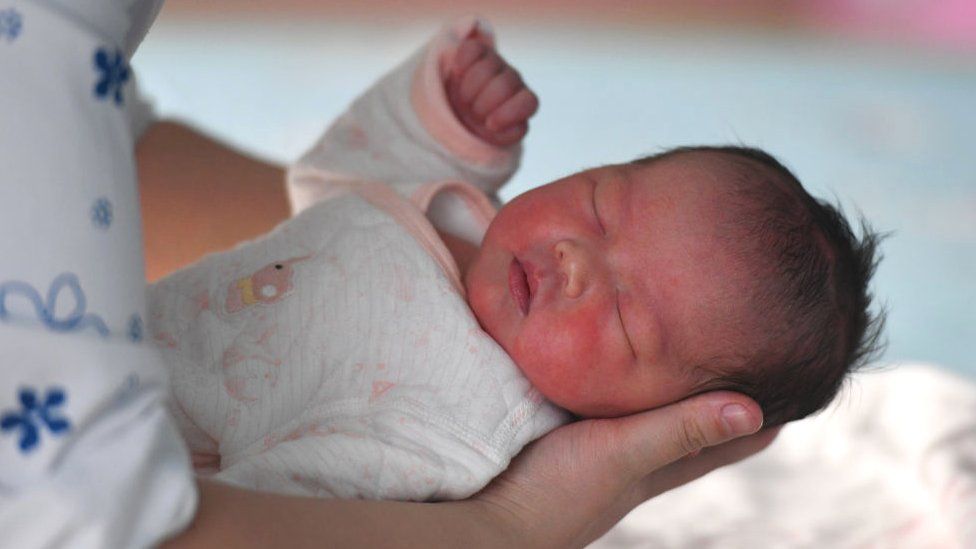 Getty Images
Getty ImagesChina’s population has declined for a second consecutive year, exacerbating concerns around the future growth of the world’s second-largest economy.
Once the world’s most populous nation, China was overtaken by India last year according to the UN.
National data showed its population stood at 1.409bn , down some 2.08m from the previous year. Comparatively, India’s population stands at 1.425bn.
The decrease is more than double the previous year’s loss of 850,000 people.
That had marked the country’s first downturn in 60 years – the result of decades of falling birth rates and rapid urbanisation.
Beijing says the birth rate is now down to 6.39 per 1,000 people – the lowest on record. This is on par with other advanced East Asian countries with Japan’s birth rate at 6.3 and South Korea’s at 4.9.
After decades of a controversial one-child policy in place from 1980-2015, China has spent the past years trying to slow its plunging childbirth rate with subsidies and other policies to encourage families. In 2021 it allowed couples to have up to three children.
However the changes have borne little impact with young people citing deterrents like the cost of living in cities and career priorities for women.

On Wednesday, Chinese internet users pointed to these problems.
“If you let people live more easily, with more security, of course there will be more people wanting kids,” one user wrote in a top-liked comment on Weibo.
However, one analyst said China still has “plenty of manpower” and “a lot of lead time” to manage the demographic challenge.
“They are not in a doomsday scenario right away,” Paul Cheung, Singapore’s former chief statistician had earlier told the BBC.
Economic woes were further highlighted in 2023, with the country experiencing several aftershocks after re-opening from a three-year Covid period.
Last year it battled through a widespread property crisis, falling consumer consumption and record youth joblessness.
Annual data on Wednesday confirmed the struggles – showing the economy had grown at one of its slowest rates in more than three decades – with GDP expanding at 5.2% to hit 126 trillion yuan ($17.6 trillion) in 2023.
This marked the weakest performance since 1990 – excluding the pandemic years – which saw a record 3% GDP rate in 2022.
The latest population data is likely to reinforce fears about the economy, experts say. China has long relied on its massive workforce as a key driver of its economy.
But the country is facing increased pressure on its healthcare and pension systems as its retiree population grows.
That group is expected to increase 60% to 400 million people by 2035- larger than the entire population of the United States.
China’s death rate was also at its highest in decades in 2023- 7.87 deaths per 1,000 people up from the rate of 7.37 deaths in 2022. This was the highest since 1974 during the Cultural Revolution, Reuters reported.
A wave of Covid deaths after China opened up is believed to have contributed to the population decline in 2023.
-
-
20 January 2023

-
-
-
16 March 2023

-
-
-
10 February 2023

-

